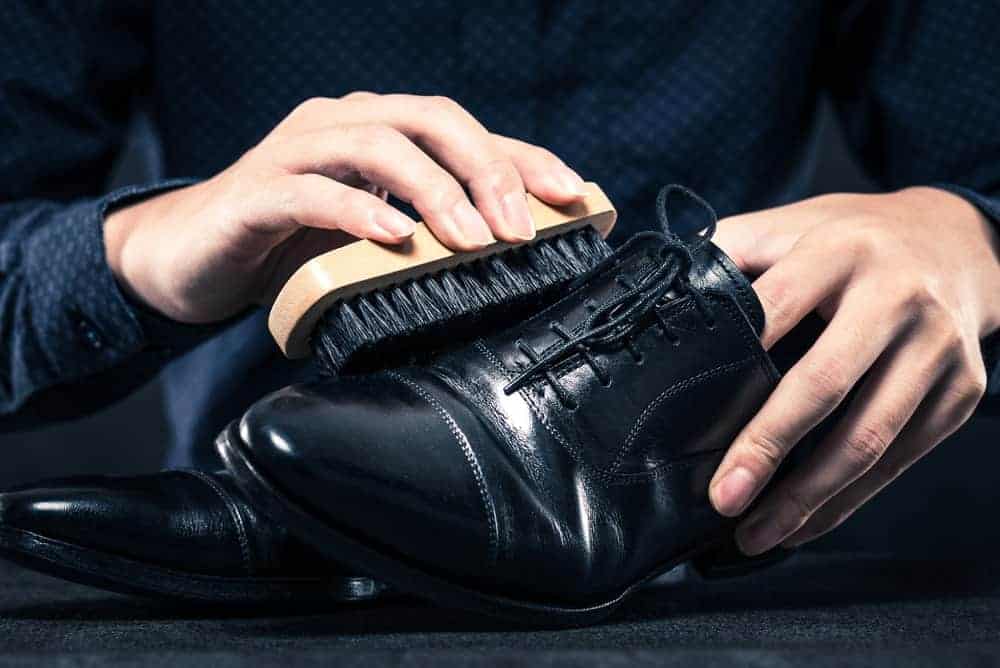Having nice, shiny shoes help to complete a polished look and style, but choosing the right shoe polish can be tricky. Shoe polish can be used to help make your shoes shine, give your shoes added waterproofing, or even help to restore and improve dry and cracked leather.
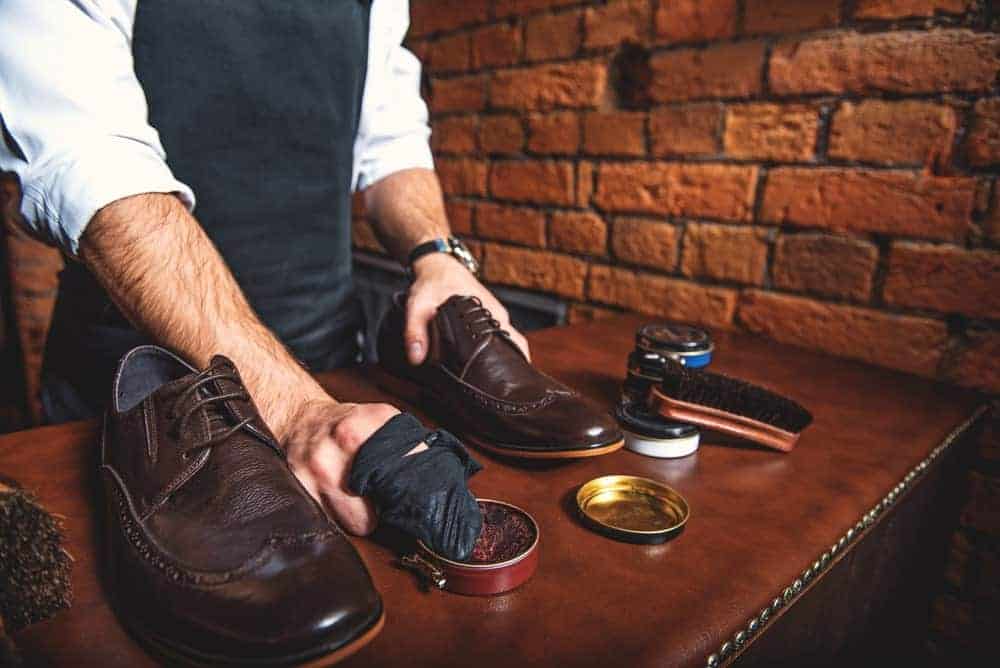
You are all dressed up, looking like a million dollars, and then start putting your dress shoes on to complete the look. Imagine your horror to find your leather dress shoes dry, faded, and cracked in the creases. Nothing ruins a formal look faster than unkempt shoes.
Luckily, most leather can breathe new life with a fresh shoe polish application and a bit of elbow grease. Spit shine your shoes back to life with shoe polish. Choosing the right polish for your shoes is quite another story.
There are several types of shoe polish options available, and many polishes will give different effects. Below, let’s take an in-depth look at the many types of shoe polish options available, understand the pros and cons of each, and learn which polishes are best suited to which shoes.
Contents
- Types of Shoe Polish
- FAQs
- What do you have to do to keep a pair of shoes or boots in good working order?
- When polishing brown shoes, should I use a neutral or brown polish?
- How long should shoe polish dry before buffing?
- Should I use the same brush for different colors of shoes?
- What do you recommend for polishing?
- How do you prevent cracking and flaking where the leather creases?
Types of Shoe Polish
Wax Polish
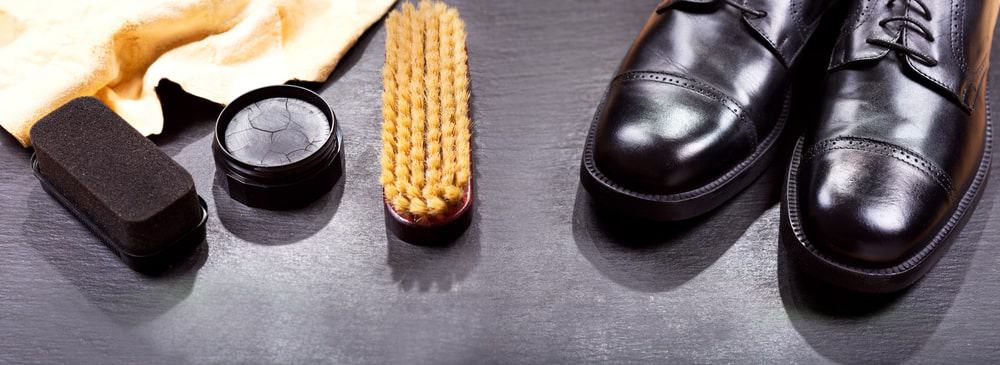
Compared to other shoe polish options, shoe wax is an excellent, multi-purpose tool to keep your shoes looking great. Wax polish is predominantly made of wax materials and includes just a small amount of pigment added to the mixture. This is the opposite mixture of what a cream shoe polish is made of.
Wax polish is usually in a small, shallow tin and is very hard to touch. Small amounts of wax are picked up with a brush and gradually applied to the shoe’s surface. Wax polish is available from several manufacturers, including Kiwi shoe polish, Saphir, and R.M. Williams.
The wax shoe polish works by gradually adding small layers of wax to the exterior of your shoe. This means that small pits, holes, and cracks in your leather surface are treated and smoothed with superficial layers of wax. With repeated polishing and coats of the wax layer, you can make your shoe appear to have a completely smooth surface.
When the shoe appears smooth, light reflects more evenly, making the shoe appear to shine. The more smooth the surface, the more shine you can build on your shoe. Similar to cream polishes, wax-based shoe polish is not permanent. If you do not like the finished look after polishing the shoe or the polish appears uneven, removing the additional wax layers with increased buffing is possible.
Wax shoe polish is mostly wax with only a little bit of pigment added to the mixture. Because of the limited about of color added, getting a perfect match to your shoe leather color is unnecessary. In fact, because of the limited amount of color added, some people like to buy a black shoe polish and apply it to the bottom of a tan shoe to give the appearance of a patina look. The limited amount of color allows you to gradually apply a dark color without going too extreme.
One of the biggest benefits of using a wax shoe polish is that wax is a hydrophobic material. Applying a wax shoe polish to your shoe can give your shoes an added waterproofing layer. This is a great way to protect your shoes in all weather conditions and keep your leather looking great for years.
Similar to other shoe polish types, wax shoe polish is applied with a horsehair brush. A dauber brush is used to apply the polish, and once dried, a horsehair buffer brush is used to create a shiny finish. Wax polish is an excellent choice for people who want a smooth mirror shine on their shoes.
A specialty wax polish called Saphir Mirror Gloss is a great product to help get a gleaming and mirror-like finish for your shoes. Adding a horsehair shine brush can increase the amount of shine.
Cream Polish

A tried and true option to keep your leather footwear looking great wear after wear is a cream polish. This is a special type of shoe polish that differs from wax polish. A shoe cream polish is usually made up of a cream base that is rich in pigment.
Most cream polishes are made almost entirely of cream, with just a little added wax to restore and protect the leather. Many shoe cream polishes also have a small amount of shea butter added to the mixture, which helps to condition the leather.
Cream polish is mostly used to help protect the color and vibrancy of the leather. This is a great option to help reduce the signs of fading in your leather and mask uneven coloration. Cream polish can help restore the color of your shoes and even give your shoes a slight shine. The shine is subtle, often compared to the shine of a leaf.
The cream polish works by slowly applying a thin, superficial layer of pigment onto the shoe’s surface. Unlike permanent dyes, the cream polish can be buffed away and removed if the application is too thick or the color is the wrong match. Because the cream polish is not a permanent option to protect your shoes, the application is required fairly regularly to keep your shoes looking great.
Compared to other types of shoe polish, the biggest attraction to a cream polish is that color plays a big role in restoring the appearance of your shoes. This is a pigment-based polish that works to restore faded or uneven color.
For this reason, cream polish comes in a range of color options, and it is essential to find a color that closely matches your leather. Of course, because the shoe cream is not permanent, it is possible to buff away a color that doesn’t match perfectly.
Most shoe cream is applied to the shoes using a horsehair brush. First, a horsehair brush called a horsehair dauber brush is used to apply the shoe cream to the shoe. Once dried, the polish is buffed to an even shine with a horsehair brush called a horsehair shoe buffing brush. Continue buffing the shoe until you have an even color and a muted shine.
Although shoe cream polish is an excellent choice for most smooth leather shoes, it can damage some leather. If your shoes are made of shell cordovan leather, shoe cream will not be a good option. The grain with shell cordovan leather has a very tight, natural grain that gives the leather its shine. When applying a cream polish, the shoe cream can actually work to loosen the grain, ruining the leather.
Carnauba Wax

Like other traditional shoe wax options, Carnauba wax is a popular choice to help repair and replenish the leather on your shoes. The shoe wax can fill in small holes and cracks in the leather giving a smooth and finished shine.
Carnauba wax works and functions the same way as a traditional wax but is made of all-natural wax ingredients that make it a popular choice.
Several people swear by Carnauba wax because it is a smoother, faster, and better option than traditional shoe wax. Many major shoe polish manufacturers will include a high level of carnauba wax in their compounds because of its smooth properties.
Traditional wax polish used for shoes is made of petroleum-based or animal fat-based compounds that can make the wax oily, requiring multiple coats. Carnauba wax is made from a natural leaf, which goes on smooth and thick, with many polishing efforts requiring only one coat.
Carnauba wax allows you to get more shine with less effort. Like other shoe wax, Carnauba is made with just a small amount of pigment, and many manufacturers offer a limited range of shoe wax colors. As long as you find a color close to your leather color, you will obtain the desired results.
Carnauba wax is a popular option for many people, not only because of its smooth coverage but also because it is a sustainable option. The oil is derived from Brazilian palm tree leaves. Every year, only about 30% of the leaves are harvested for wax production, leaving enough trees to capture carbon still and grow well into the future. This all-natural wax is easy to use, sustainable, and natural.
Similar to other wax shoe polish options, Carnauba wax has a hydrophobic property. This means that the wax can help to repel water, adding an extra waterproofing layer to your shoes. Like other wax shoe polish options, Carnauba wax is applied with a horsehair dauber brush, allowed to dry, and then buffed with a horsehair buffer brush until a nice, even shine forms.
Leather Conditioner
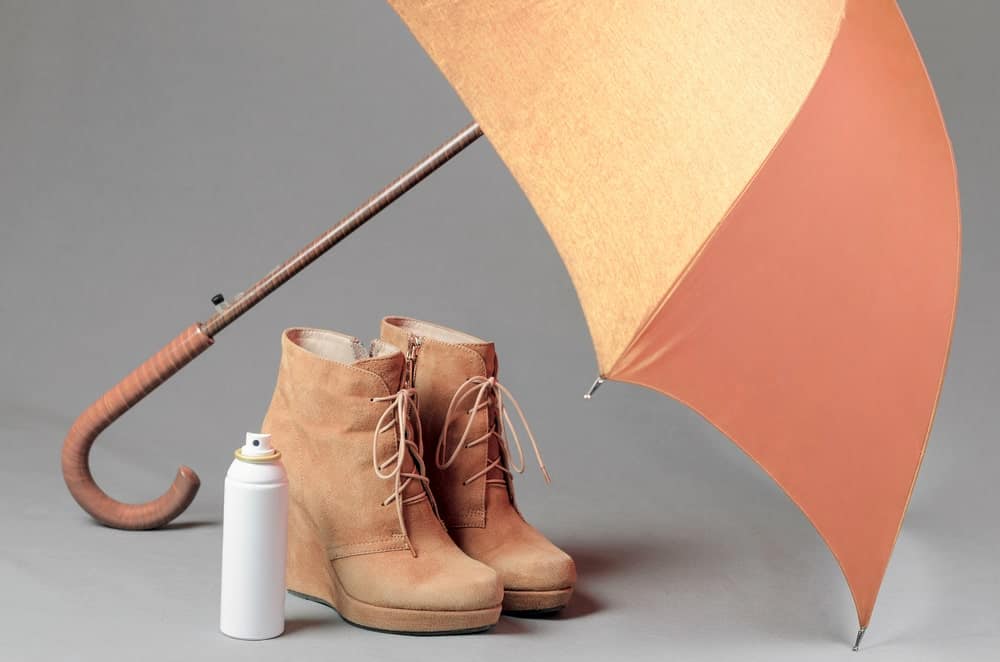
Unlike traditional shoe polish, a leather conditioner can become your best friend when it comes to caring for your leather shoes. Leather conditioner can give the same effect as a leather polish but can help keep your leather in good condition, replenishing the very fibers that make up the leather. Even though shoe polish can help make your shoes appear shiny and smooth, it is possible to add too much polish, damaging the leather.
Traditional shoe polish is brushed on top of the shoe, adding microscopic layers of material to fill in cracks and holes and give leather shoes a shine. Comparatively, the leather conditioner penetrates the leather’s actual skin, soaking into the material itself.
This allows the leather conditioner product actually to help heal and protect the leather. Having a leather conditioner is a vital part of regular shoe care. The conditioner fills in the gaps between the leather’s individual fibers and pores and helps to exude water from the leather material itself, replacing it with conditioner.
This helps to keep the leather smoother, softer, and less prone to cracking and drying out. Leather conditioner will work even better if it is used in conjunction with a shoe cleaner first.
Further, as part of your regular shoe care, a leather conditioner is a great option to help waterproof and weatherproof your shoes. Without conditioner, the leather’s natural oils will gradually escape the leather, leaving an opening for water to enter the leather.
When the water enters and dries, it can cause the leather to crack and become stiff. Conditioner can help prevent leather shoes from drying and cracking, but it can help restore damaged or worn leather.
Many people choose only to use leather shoe conditioner for their leather shoes and won’t use a traditional wax or cream. Not only do you have the ability to protect and restore your leather, but you can make it appear smooth and beautiful too.
Leather conditioner can help even out the leather surface and give a polished and shiny appearance, just as shoe polish can. With a leather conditioner, you can practice good shoe care and have your shoes shine at the same time.
Mink Oil

Mink oil has been a popular leather conditioner and treatment method and is commonly used as a leather polish. The oil is made from the abdomen fat of a mink, making it a natural product. Compared to wax or cream that puts a layer of material on top of the shoe, mink oil is a natural oil that replenishes the natural oils found in leather goods.
Native Americans commonly used mink oil to treat their leather goods, and this has been a popular boot polish since the 1950s. After WWII, the fur coat industry boomed, leaving plenty of mink byproduct to be used for consumption. Mink oil quickly hit the market and has been a staple of proper shoe care ever since.
Mink oil has the ability to reverse the damage done to leather boots. As leather ages, the natural oils deep within the leather start to dry out and escape. Oil is replaced by water, which can further dry the leather, leading to cracking and stiffness.
The mink oil can penetrate the leather and help lubricate the individual fibers in the leather. Not only does this make the leather smooth again, but it can help make the shoes more flexible and soft.
Like other products intended to protect and polish your shoes, mink oil can help make your shoes more water-resistant. This is because oil naturally repels water. It is important to note that while your leather shoes will do a good job of wicking water away, they will not be fully waterproof with just mink oil.
Mink oil itself is clear, with no color added to the oil. This makes it appropriate to use on any leather color. To apply the oil, use a soft cloth dipped into the oil. Work the oil into the leather and allow to sit for at least 10 minutes. Many people have the most success leaving the shoes to sit and absorb the oil overnight. In the morning, buff away any excess oil that has not been absorbed.
Saddle Soap
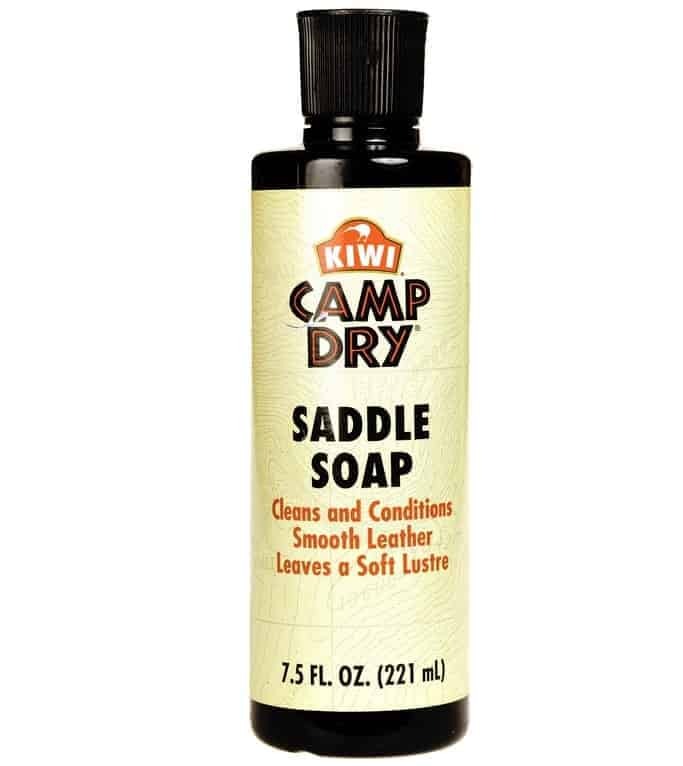
For a versatile and natural option for your leather goods, many people prefer to use saddle soap. This is both a leather cleaner and conditioner combined into a comprehensive shoe care product. Saddle soap is usually made of a mixture of lanolin and beeswax.
Lanolin is the oil extracted from a wool-bearing animal. While there are many types of wool animals that can produce lanolin, most lanolin used in saddle soap is from sheep. Both lanolin and beeswax are naturally occurring, making saddle soap safe and forgiving.
Just like other polishers and oils, saddle soap works to restore moisture to the leather. As leather ages, the natural oils found within the fibers start to degrade. As oil escapes the natural leather, it often absorbs water, causing leather to dry out.
This can lead to fading, cracking and often causes the leather to be stiff and inflexible. Saddle soap works to condition the leather, adding natural oils back into the fibers. This lubricates the leather, rehydrates the fibers, and helps to keep your leather from cracking and drying out.
Plus, saddle soap has the added benefit of working as a soap to remove stains. Saddle soap contains a cleaning compound that can scrub away just about any stain you can think of. This makes saddle soap a multi-functional product that can remove stains and soften your leather, allowing it to look great for years on end.
While saddle soap can be used for leather shoes, it can be applied to any leather goods such as coats, purses, wallets, or, well, saddles!
Saddle soap is straightforward to use. Simply apply some of the soap onto a damp cloth or soft sponge. Apply the soap in a clockwise, circular motion, as if you were waxing a car. It can help to mentally divide the leather shoe into sections to ensure that you cover the entire shoe area.
Continue buffing the saddle soap into the fibers of the leather until the soap is completely absorbed. While saddle soap can be used as a leather conditioner, it is a good idea to follow up your saddle soap application with a traditional leather conditioner to make sure your leather stays soft for years.
Liquid Shoe Polish
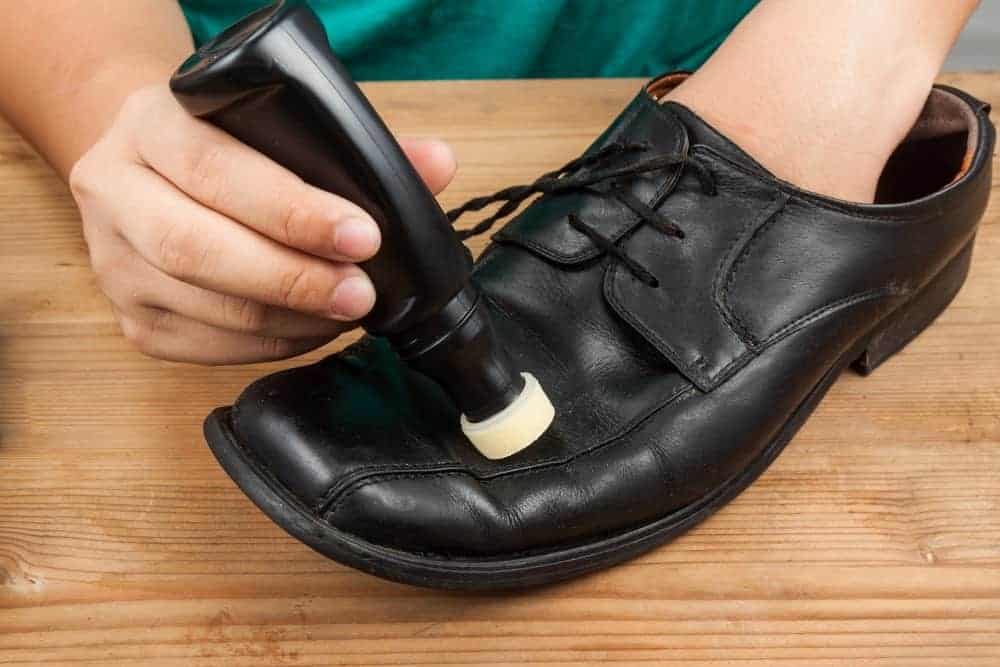
For those who are short on time or want a no-mess application with a spit shine finish, liquid shoe polish is an excellent option. These are effective, fast, and easy to use. Plus, liquid shoe polish is readily available and can be used to help give your shoes a last-minute shine in a pinch. Popular brands for liquid shoe polish include Kiwi shoe polish and Nugget shoe polish.
Like traditional shoe polish, the liquid shoe polish is intended to apply a thin layer onto the shoe’s surface. This can help fill in small cracks and holes, giving the shoe’s surface a softer finish. When the shoe has a smooth finish, it will reflect light better, making the shoe really shine. Because the product is added to the top of the shoe, it is not permanent and can always be buffed away. However, the liquid shoe polish does not penetrate the leather material and will not condition the leather.
The main attraction for people who purchase liquid shoe polish is the all-inclusive application. The liquid polish is included in a bottle, complete with an applicator sponge. Simply squeeze the bottle to allow some polish to ooze onto the sponge. Apply the polish to the surface of the shoe and buff with the attached sponge. Once the polish has been fully buffed into the shoe, the polish will restore the shoe to its former glory.
Liquid shoe polish has a limited range of colors, but it is possible to find black shoe polish, brown shoe polish, and a polish that is considered a neutral color. The shoe polish can help to add a water repellant layer to your shoes but stops short of making your shoes waterproof. Compared to other shoe polish and leather conditioning options, this is not as comprehensive but is a great solution for people who lack a shoe shine kit and want a smooth, polished look with minimal effort.
FAQs
Keeping your shoes polished to a spit shine finish doesn’t have to be difficult or labor-intensive. Keeping your leather shoes looking great for years to come with some minimal maintenance using traditional shoe polish or leather conditioner is possible.
Of course, with so many options on the market, it can be difficult finding the right product for your needs. Below, we have outlined some frequently asked questions surrounding types of shoe polish.
What do you have to do to keep a pair of shoes or boots in good working order?
Leather is a natural material that is not only beautiful but practical and durable too. Leather is thick, warm, and will last for years with the right care. Of course, keeping your boots and shoes in good working order will require a little maintenance and regular upkeep to maintain their beauty.
When it comes to caring for your shoes, there are two paths to take. One method is to polish the shoes, while the other is to condition the shoes.
Polishing your leather shoes or boots regularly can help fill in holes or cracks developed in the leather. Not only does this make the surface of the shoe shine and appear smooth, but it can help keep water out of your shoes.
Adding shoe polish is a great way to maintain your shoes’ color and combat fading and sun damage. Shoe polish often comes in several different shades and can be made of a cream or wax consistency.
Comparatively, a leather conditioner will help to restore and protect the leather. A leather conditioner helps to penetrate the leather fibers, restoring the natural oils that occur within the leather. Adding a conditioner makes it possible to restore leather, make stiff leather soft, and even repair minor cracks and holes.
The leather conditioner also adds waterproofing since most conditioners are oil-based, a natural water repellent. While you will get the most shine from traditional shoe polish, adding a leather conditioner will still give you some finishing shine.
When polishing brown shoes, should I use a neutral or brown polish?
That really depends on the type of polish you are using. Some shoe polishes, such as shoe wax, only contain small amounts of pigment. Using a brown or neutral polish should not make a big difference because so little color is transferred to the shoe’s surface with the microscopic layer of wax.
Other products, such as shoe cream, use more pigmentation to polish the shoes. If you are using a shoe cream to polish your shoes, be sure to use a brown polish that closely matches the shoe leather color. More of the color pigmentation is transferred to the shoe when you use a cream-based polish, so it helps to choose a close color to your shoe.
How long should shoe polish dry before buffing?
For most shoe polish applications, waiting about 10 minutes should be enough before you start buffing the polish. This gives the polish a chance to fully dry, allowing you to buff the finish to a beautiful shine.
There are, of course, exceptions to this. When using oil-based products or leather conditioners, you want to leave the polish on the leather shoe until the leather has absorbed as much as possible.
While waiting 10 minutes is certainly sufficient, some leather conditioners, like saddle soap, can be left overnight before buffing the polish away. This allows the polish to fully penetrate and saturate the leather, making it as smooth and protected as possible.
Should I use the same brush for different colors of shoes?
Normally a shoe shining kit will include two different brushes. The first brush is a dauber brush, made of horsehair, used to apply the actual polish, either a cream or a wax, onto the shoe’s surface. The dauber brush is dipped into the shoe polish directly.
While many wax-based polishes do not have a great deal of color pigmentation, it is possible to have some of the colors stay on the brush. That means that if you want to maintain your shoes’ color, it is best to have a different dauber brush for each shoe’s color. Though, many wax polishes have minimal pigmentation, so color transfer and discoloration will be minimal if you use the same brush.
The second brush that is included in a shoe shining kit is the buffing brush. Also made of horsehair, this brush is used to buff away the cream or wax finish that you have just placed on the surface of your shoe. Because you are buffing away the dried wax polish or cream polish and not directly dipping the brush into the polish, you can keep one horsehair buffing brush for all of your shoes, regardless of color.
What do you recommend for polishing?
The type of polish you use to keep your shoes in good working order really depends on your wants and needs. Different polishes will have different effects on your shoes and change the level of ongoing care and maintenance required.
If you are interested in having a mirror shine finish to your shoes, you will probably have the most luck with a shoe polish wax or a shoe polish cream. Both of these options are directly applied to the surface of the shoe to create a smooth surface.
When the polish is buffed away, the shoe is left shiny. While this is a great way to maintain your shoe’s color and restore the shine, it has a minimal impact on protecting your shoe long-term.
If keeping your leather soft and in good condition is your priority, you will probably want to turn toward leather conditioners or oil. Products like saddle soap or mink oil will be a great option for you. These products will penetrate the leather itself and soak into the pores.
This will help restore the leather’s natural oils making your shoe leather soft again. This can help to make your shoe water repellent, further protecting the leather. Leather conditioner can even help to restore dry and cracked leather, giving your shoe life again.
There are also plenty of specialty shoe polish options available for those with niche interests and needs. Carnauba wax is a wonderful shoe polish option that is all-natural and sourced from sustainable farms in Brazil. For those who want a convenient and fast result, a liquid shoe polish, complete with an applicator, may be the best option.
How do you prevent cracking and flaking where the leather creases?
Leather will begin to crack and flake in the creases of your leather shoes, such as the areas at the base of the toe box. No matter how expensive or how soft the leather is, this is a problem inherent in the actual leather material itself. This is because leather is a natural material that has oil between the fibers.
As a person flexes their shoe, the oil is forced out of the leather pores. This eliminates any lubricating oils between the individual fibers, creating friction between the fibers. Increased friction dries the leather, making it crack and flake. The vacuum created by the evacuated oil can invite water into the pores, further drying leather.
To help prevent cracking and flaking in the creases of your shoes, you must help the leather maintain its natural oils. This can be accomplished by applying a leather conditioner to your leather shoes. The conditioner will be able to penetrate the leather, adding oil between the fibers.
This lubricates the fibers, preventing cracking and creating a smooth finish to your shoe. Leather conditioners come in several forms, including standard conditioner, mink oil, or saddle soap.




